Each year brings a diverse group of five movies as the nominees for the Academy of Motion Picture Arts and Sciences Awards for Costume Design. This year the nominees for the 2017 movies were: Jacqueline Durran for Beauty and the Beast; Jacqueline Durran for Darkest Hour; Mark Bridges for Phantom Thread; Luis Sequeira for The Shape of Water; and Consolata Boyle for Victoria & Abdul. The highlights of the nominees and Oscar recipient follow:
BEAUTY AND THE BEAST. This is a live action version of Disney’s animated film which was itself based on the classic 1946 French Jean Cocteau filming of an 18th century fairy tale. The movie was directed by Bill Condon and starred Emma Watson and Dan Stevens, with a strong supporting cast. Costume designer Jacqueline Durran has also been nominated this year for Darkest Hour. She previously won a Best Costume Oscar for Anna Karenina in 2012, and was nominated for Mr. Turner (2012); Atonement (2007); and Pride and Prejudice (2005).
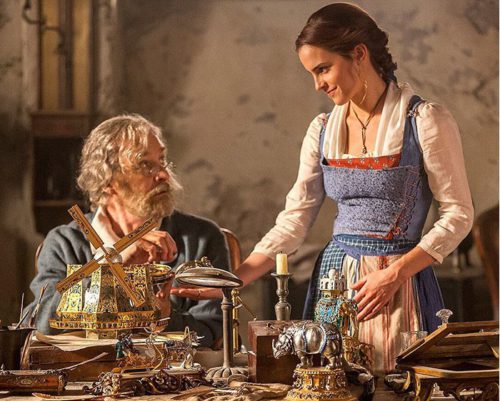
Jacqueline Durran wanted to stay true to the animated Disney version of the story, “Those costumes exist in people’s imagination,” she stated. “…all I wanted to do was to honor what they expect those costumes to be in a live action movie.” Durran also looked to 18th century French folk costumes for details. Women’s garments were layered, including undergarments – for warmth as well as function. The pants-like bloomers were Emma Watson’s favorites.
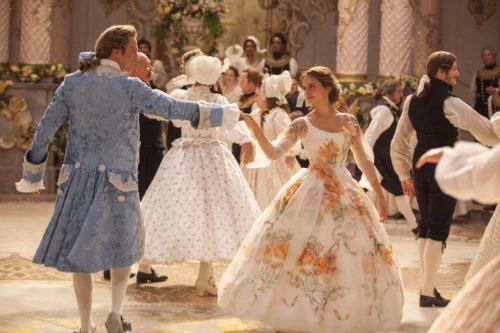
The floral print dress that Belle wears in the dance scene above is based on an 18th century piece of fabric that designer Ms. Durran bought as a student. She had an artist re-draw it and had the fabric printed in larger scale so it wouldn’t look like a wedding dress. The flowers were also re-printed over each other. The men’s frock coats were laced with Swarovsky crystals that gave them sparkle under the lights.

Her ball gown is made of satin organza, taffeta, and tulle. Emma Watson did not want to wear a corset, but then again, she didn’t need to. This ball gown in the story is made by Madame Garderobe (Audra McDonald), who gets the gold pattern from the ceiling and puts it around the dress. Although subtle, the pattern can be seen on the three layers of the skirt itself. Some sparkle was added by adding Swarovski crystals over the pattern. Beast’s coat was made by Plumette (Gugu Mbatha-Raw) with her feathery brush in the story, and thus had a more painterly quality. The movie is a combination of fantasy and historical, thus sure to be a favorite with the Academy voters.
DARKEST HOUR. Darkest Hour is the second movie to be nominated for a Best Costume Oscar by Jacqueline Durran, in addition to Beauty and the Beast above. Directed by Joe Wright and starring Gary Oldman and Kristin Scott Thomas, this is the story of Winston Churchill’s ascent to prime minister during the early days of the Battle of Britain.

Jacqueline Durran has designed the costumes for several of director Joe Wright’s previous movies, including Anna Karenina for which she won an Oscar. After discussing costuming Darkest Hour, with Wright, it became clear what was needed, “… we were doing a replication of Churchill as far as we could. And all the members of the parliament, we were looking to replicate what they’d look like and bring out the individuality in each of the costumes, each of the men, so you have a feeling of their characters,” she stated. In the case of Gary Oldman’s costumes as Churchill, he first had to have a prosthetic “fat suit” made in the right dimensions. It was from there that the costumes were fitted. She said seeing Oldman after he was fitted in his prosthetics and costume was “a magical transformation.”

Durran said of the costumes for the movie, “We really have to work to build a world for the performance, that’s what the people connect with. They connect with the performance and the themes of the movie. The costumes will work if that part is creating the whole. With ‘Darkest Hour,’ you don’t notice the costumes or the sets, you notice the whole thing together. The building of the world and you believe this world that Churchill is in, all those things and it’s all because all those things work together.” Indeed. Although Academy voters love period movies, the predominance of male costumes in this movie will be a disadvantage in the voting, in my opinion.
THE SHAPE OF WATER. The costume designs for the movie were done by Luis Sequeira. Directed by Guillermo del Toro and starring Sally Hawkins with Michael Shannon, Richard Jenkins, and Doug Jones. The story inspired by Creature of the Black Lagoon , takes place in the early 1960s in a research facility where a female janitor forms a bond with an amphibious creature held in captivity. The movie has garnered 14 Academy nominations including Best Picture, and Best Costume Design, a first for Luis Sequeira.

Much of the movie is dark, and is shot after hours when Elisa (Sally Hawkins) works at the Lab as a janitor. But she also watches old movies with her neighbor played by Richard Jenkins. They watch Fred Astaire and Ginger Rogers movies and Elisa fantasizes about them, producing a dream sequence in the movie where she wears a white Ginger Rogers-style gown. When Luis Sequeira first saw Sally Hawkins fitted for the dress, she had her hands to her face and said, “I can’t wear this, it’s too beautiful.”


Sequeira collected fabric swatches from Los Angeles, New York, Montreal, and Toronto for the gown, and combined his favorites into the ivory colored gown. Sequeira said “Although the sequence in which the dress appears is so short – I think its a striking piece of cinema. It was magical when we shot the scene and even more so when we watched it on the big screen.”
The underwater scenes were not actually filmed in water, but the look was achieved through lighting in a process called “dry for wet.” the bathtub scene was filmed in actual water, however, and the outdoor rain scene was filmed in pouring rain. For that scene the costumes had to have inter-lining to keep the actors fairly dry.
VICTORIA & ABDUL. This movie is directed by Stephen Frears and has its costumes designed by his frequent collaborator, designer Consolata Boyle. They have worked previously on Mary Reilly (1996), The Queen (2006) and Philomena (2013). Ms. Boyle has previously been nominated for The Queen and Florence Foster Jenkins (2016). Victoria & Abdul,” is a story of the friendship that grew between Queen Victoria (played by Judi Densch), with one of her Indian servants, Abdul Karim (Ali Fazal), over the last 15 years of her life.
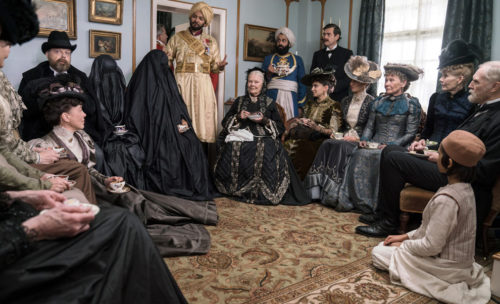
As is usual for recent historical movies, authenticity is called for. Yet Ms Boyle had to develop character and status in her costumes. An interesting visual in the movie is the contrast in costumes between the somber colors of the Queen’s wardrobe and her court, and the vibrant colors of Indian dress. “I used fabrics, color, weight, texture and embellishment to reflect the difference between their worlds and to develop the stories of each character,” Boyle explains. “When we first meet Abdul, he wears simple, unbleached linen and cotton kurtas, chogas and churidars; later this evolves to rich, heavily embossed silks and then to his royal uniforms.” But the real contrast was in the plot, as the relationship between the queen and Abdul grew closer, and the court was shocked and then ever watchful.

As was the formal etiquette for mourning dress in that era, wardrobe colors changed from black to mauve and gray, even white, over time. Ms. Boyle introduced some of those colors in Victoria’s wardrobe. Although somber, mourning clothing at the time, and also in the movie, was embelished on the surface embroidery, lace, and use of jet beading. The latter provided sparkle on a black costume. Ms. Boyle and her team searched for vintage fabrics including silks and Victorian trim in auction houses in London and elsewhere. She needed to have fabrics that recreated the look and weight of substantial Victorian garments.

Consolata Boyle also liked working with the Indian costumes. “I really enjoyed some of Abdul’s later costumes—especially the pajama trousers. One of the first areas I studied was historical fabric, so I’m always fascinated by fabric in India and the subcontinents. The sophistication is magnificent. The shapes of the garments are so simple yet so utterly beautiful. I absolutely love that.” And of course there was working with Dame Judi Dench. Designer Boyle said about her, “Like all great actors, she knows how to use her costume. She knows how to utilize every piece – every glove, every bag.”
Although there always seems to be a Queen Elizabeth or Queen Victoria movie in the Best Costume contention, this is a worthy candidate, and Academy voters love their historical costume films.
PHANTOM THREAD This movie directed by Paul Thomas Anderson stars Daniel Day Lewis, Lesley Manville and Vicky Krieps. Its costumes were designed by Mark Bridges, who won an Oscar for The Artist (2011) and was nominated for Inherent Vice (2014) where he previously worked with PaulThomas Anderson. Phantom Thread is the story of the obsessive mid-1950s London couturier Reynolds Woodcock, whose business and home is shared by his Hitchcockian, Mrs Danvers – like sister Cyril, and the string of model/muses he invites into his life – until he tires of them. At that point he asks Cyril to get rid of them. This usually happens after breakfast when the young women make too much noise buttering their toast.
Phantom Thread was written by Anderson, after discussing the idea with Day-Lewis. While supposedly not based on any individual couturier, they had thought about Balenciaga and his marvelous and influential fashions. The Anglo-American designer Charles James, brilliant, eccentric, and famously possesive of his fashion creations, had to be an inspiration as well. Day-Lewis prepared for the role by spending most of a year as an apprentice at the New York City Ballet costume department, where he learned how to sew, make buttonholes, cross-stitch and even cut patterns. Day-Lewis and Bridges also visited the V&A Museum’s couture collection.

As Woodcoock, after the strains of producing his last fashion creations, his sister suggests he go to the country house for a few days to rest. He agrees and it’s there, having breakfast at the local inn, that he meets Alma, the waitress that he invites to model his designs and become his latest muse.

He says she has the perfect figure for modeling his creations. A simple village girl, she is flattered, and soon falls in love. Though simple, her will is made of strong stuff. And she will not be gotten rid of, no matter how loudly she butters her toast and no matter how disruptive she is to the house’s other routines.

An early scene at the House of Woodcock has a countess (played by Gina McKee) being fitted for an evening gown. This particular gown’s design was based on Day-Lewis’ own rough costume sketch. Both director and costume designer were generous in giving him ownership in the design process, especially as this design was repeated with a different color scheme for Alma to wear later in the Woodcock fashion show. With hints of previous centuries, it has little resemblance to mid-fifties fashion.
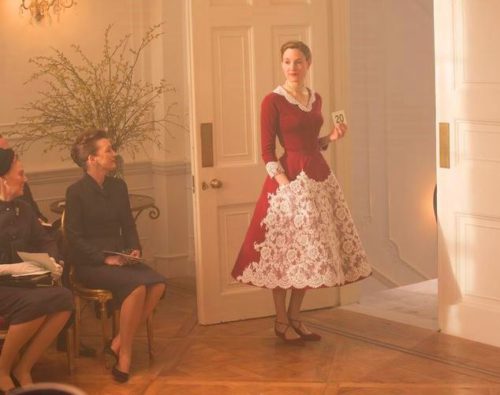
Alma models a red dress with lace in a House of Woodcock fashion show (the number she holds indicates the creation number for ordering the item). The garment refers back to Woodcock’s and Alma’s first meeting when she was a waitress – the lace symbolically serving as and resembling an apron. This was not meant as a put-down of Alma. The American designer Adrian cleverly used the humble fabric of gingham in many of his expensive garments, even in evening gowns. The red dress above was actually director Paul Thomas Anderson’s idea, “Can we take something she wears earlier and turn it into high fashion?” he asked Mark Bridges.
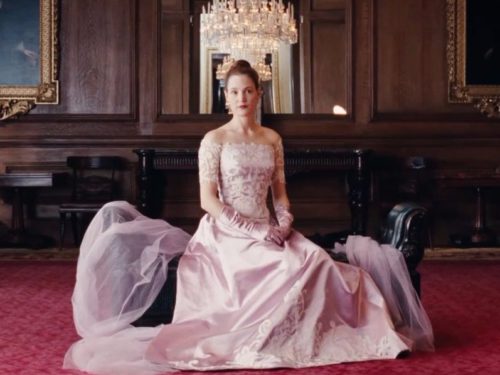
The gown above that Alma models is the pretiest of the costumes in the movie. The colors that prevail in the House of Woodcock are largely jewel colors, and particularly purples and violets and lavenders – colors that match his socks. And colors that were not much seen in mid-1950s fashion. But they were the colors that Daniel Day-Lewis liked. Mark Bridges had some rare 17th century Belgian lace that was used for the gown. The lace had another role in the movie. As explained by designer Mark Bridges, “We had to schedule the filming so he could use it as a single piece when he’s showing Alma in his shop and saying, ‘I saved this piece from the war,'” said Bridges. “And then we took it away and cut it, during which everyone held their breath.”
The production of the costumes for the pricipal actors (many others came from a costume house in Rome) were made in London. Couture seamstresses and a pattern cutter (Cecile Van Dyke) fabricated the costumes made-to-measure. The team of seamstresses working at the House of Wookcock were professional costume makers and included two retired couture house seamstresses.
The background work on Phantom Thread was impressive. As a movie whose story is focused on couture, however, I was disapointed. I won’t get into the neurosis of the character of Woodcock. Many fashion and costume designers had extreme pressure on them – having to create beauty, fashion, character, dreams and money out of their heads regularly- only to succumb to alcohol, drugs, or suicide. And I won’t compare Phantom Thread ‘s fashions or its fashion show to 1950s classics such as Adrian’s Lovely to Look At, or Helen Rose’s Made in Paris or Lucy Gallant. As a window to fashions of the 1950s, it was a view at the new look, architectural form in gowns, silk taffeta and foundation undergarments, and the beauty of lace. Beyond that, it was a brave if idiosyncratic look inside the pained mind of a fashion designer. I think there was too much tinkering and overload placed on Mark Bridges in this movie.
2017 was not a particularly great year for costume design in film. The costume designers always do a great job given the script, time, and budget constraints they are given. It’s not that we need epics, but the movies were not rich in costuming potential. And movie producers usually give too little time and funding for costume designers to do their best work. They nonetheless did their job, which is to develop character and therefore contribute to the plot. The movie with the most potential, Phantom Thread, a movie all about clothing and its creation within one person and its sharing with others, seemed to lose its own way.
I had predicted that Victoria and Abdul would win, but Mark Bridges received the Oscar for Phantom Thread. He had said earlier that working on the movie was the high point of his career.
Views: 466


This may surprise you, Christian, but I liked “Phantom Thread” even more the second time around. And so, of course, was pleased the film won the costuming award.
I hadn’t known this and only learned after the Oscars that Lesley Manville was Gary Oldman’s first of five (!) wives (I thought that many marriages went out with the Golden Age stars). Would’ve been interesting had they both won.
I always enjoy your annual recaps. Thanks for the details on the costume nominees for 2017!
I’m glad you enjoyed the post on the costume contenders Lady Eve. I didn’t know about Lesley Manville – how interesting. She did a great job in Phantom Thread. As I think you know, this was not my favorite film. I may like it more the second time around, however.